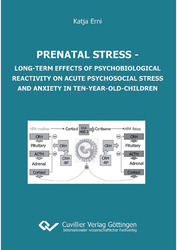| Departments | |
|---|---|
| Book Series (96) |
1378
|
| Nachhaltigkeit |
3
|
| Gesundheitswesen |
1
|
| Humanities |
2363
|
| Medienwissenschaften | 16 |
| Theology | 57 |
| Philosophy | 102 |
| Law | 422 |
| Economics | 850 |
| Social sciences | 416 |
| Sports science | 48 |
| Psychology | 233 |
| Educational science | 190 |
| History | 182 |
| Art | 110 |
| Cultural studies | 166 |
| Literary studies | 116 |
| Linguistics | 88 |
| Natural Sciences |
5406
|
| Engineering |
1791
|
| Common |
98
|
|
Leitlinien Unfallchirurgie
5. Auflage bestellen |
|
Advanced Search
Prenatal stress (English shop)
Long-term Effects of Psychobiological Reactivity on Acute Psychosocial Stress and Anxiety in Ten-year-old-children
Katja Erni (Author)Preview
Table of Contents, Datei (36 KB)
Extract, Datei (63 KB)
Various lines of research in animals and humans indicate that prenatal stress can have long-lasting effects on biological and psychological processes of the offspring. In particular, prenatal stress is associated with long-term disturbances in HPA axis function. Moreover, prenatal stress in animals is linked with anxiety in later life. Likewise, in humans, gestational stress has a significant impact on emotional problems of the offspring. However, to date, there have been no studies investigating the effects of prenatal glucocorticoid exposure on psychological, endocrine, and autonomic responses to a standardized psychosocial stress test in children aged 10 years. Furthermore, studies investigating the effects of prenatal glucocorticoids on anxiety in children aged 10 years as assessed by self-report as well as maternal and paternal rating are lacking. In particular, knowledge is lacking about healthy children born after the 34th week of gestation without complications (e.g. oxygen administration because of respiratory distress syndrome) as well as with no other physical diseases or disabilities after birth. In addition, to date, the long-term effects of prenatal glucocorticoid exposure in children who are healthy and show no disparities in their level of development are poorly understood. In a cross-sectional study design, a total sample of 135 children was examined. The Glucocorticoids+Tocolytics (GC+TOC) group was characterized by tocolytic treatment of the children’s mothers due to signs of preterm labor during the second trimester of pregnancy. In addition, the pregnant women received glucocorticoid treatment (betamethasone) in order to accelerate fetal lung maturation in case of preterm birth. The Tocolytics (TOC) group consisted of children whose mothers also had signs of preterm labor during the second trimester of pregnancy. These mothers, like the mothers of the GC+TOC group, were administered tocolytic treatment, but did not receive glucocorticoid treatment. In both of these groups, only pregnant women were included with no other reasons (e.g. premature rupture of membranes) for tocolytic treatment than preterm labor as reported in medical records. The CONTROL group consisted of children whose mothers experienced a complication-free pregnancy. Data 1: To investigate the psychological, endocrine and autonomic responses to a standardized psychosocial stress test for children (TSST-C) was applied. Psychological parameters using self-report questionnaires (EWL-KJ and PASA) as well as salivary cortisol and heart rate were measured during the experiment. Group comparisons revealed differences in psychological (control expectancies and stress appraisal) and in biological (salivary cortisol) parameters in children who were prenatally exposed to glucocorticoids as compared to both control groups. Data 2: The effects of prenatal glucocorticoid exposure on anxiety in children as assessed by themselves and their mothers and fathers were examined. Self-report questionnaires measuring anxiety were filled in by the children (SCAS-D and EWL-KJ). Mothers and fathers completed questionnaires measuring anxiety and emotional stability in their children (HiPIC). With respect to self-reported anxiety as wells as anxiety and emotional stability as assessed by the fathers, significant differences between the three groups were revealed in group comparisons. Moreover, we found a child-father agreement in anxiety ratings. Prenatal glucocorticoid exposure is associated with an altered psychological and biological stress reactivity in response to a psychosocial stress test even in healthy 10-year-old children. Moreover, children who were prenatally exposed to glucocorticoids showed higher anxiety values and were described as less emotionally stable than the control groups.
| ISBN-13 (Printausgabe) | 3954040220 |
| ISBN-13 (Hard Copy) | 9783954040223 |
| ISBN-13 (eBook) | 9783736940222 |
| Final Book Format | A5 |
| Language | English |
| Page Number | 128 |
| Lamination of Cover | glossy |
| Edition | 1 Aufl. |
| Volume | 0 |
| Publication Place | Göttingen |
| Place of Dissertation | Zürich |
| Publication Date | 2012-03-01 |
| General Categorization | Dissertation |
| Departments |
Psychology
Human medicine |
| URL to External Homepage | http://www.zpid.de/index.php?wahl=PSYNDEX |








